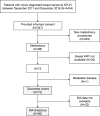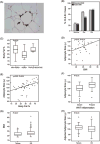Adiposity, Inflammation, and Breast Cancer Pathogenesis in Asian Women
- PMID: 29222346
- PMCID: PMC5882588
- DOI: 10.1158/1940-6207.CAPR-17-0283
Adiposity, Inflammation, and Breast Cancer Pathogenesis in Asian Women
Abstract
Obesity is associated with white adipose tissue (WAT) inflammation in the breast, elevated levels of the estrogen biosynthetic enzyme, aromatase, and systemic changes that predispose to breast cancer development. We examined whether WAT inflammation and its associated systemic effects correlate with body fat levels in an Asian population where body mass index (BMI) is not an accurate assessment of obesity and cancer risk. We also investigated whether biologic differences could account for the greater proportion of premenopausal estrogen receptor (ER)-positive breast cancer in Asian versus Western countries. Breast WAT and fasting blood were prospectively collected from Taiwanese women undergoing mastectomy for breast cancer treatment. Body composition was measured in a subgroup using bioelectrical impedance analysis. WAT inflammation was defined by the presence of crown-like structures of the breast, which are composed of dead or dying adipocytes surrounded by macrophages. Findings were compared with U.S. Caucasian women. In the Taiwanese cohort (n = 72), breast WAT inflammation was present in 31 (43%) women and was associated with elevated BMI (P < 0.01) and increased levels of body fat (P < 0.01), C-reactive protein (P = 0.02), triglycerides (P < 0.01), insulin resistance scores (P = 0.04), and lower HDL cholesterol (P < 0.01). ER+ tumors were associated with greater body fat versus other subtypes (P = 0.03). Compared with U.S. Caucasians (n = 267), Taiwanese women had larger breast adipocytes despite lower BMI after adjusting for BMI and menopausal status (P = 0.01). A subclinical inflammatory state associated with increased adiposity and metabolic dysfunction could contribute to breast cancer pathogenesis in Asian women. Cancer Prev Res; 11(4); 227-36. ©2017 AACR.
©2017 American Association for Cancer Research.
Conflict of interest statement
Figures


References
-
- Arnold M, Leitzmann M, Freisling H, Bray F, Romieu I, Renehan A, et al. Obesity and cancer: An update of the global impact. Cancer Epidemiol. 2016;41:8–15. - PubMed
-
- Eliassen AH, Colditz GA, Rosner B, Willett WC, Hankinson SE. Adult weight change and risk of postmenopausal breast cancer. JAMA : the journal of the American Medical Association. 2006;296:193–201. - PubMed
-
- Trentham-Dietz A, Newcomb PA, Storer BE, Longnecker MP, Baron J, Greenberg ER, et al. Body size and risk of breast cancer. American journal of epidemiology. 1997;145:1011–9. - PubMed
Publication types
MeSH terms
Grants and funding
LinkOut - more resources
Full Text Sources
Other Literature Sources
Research Materials

